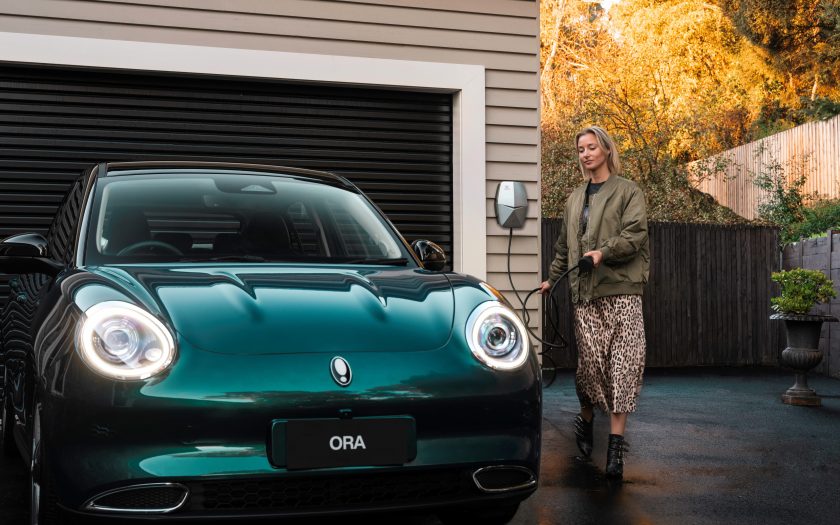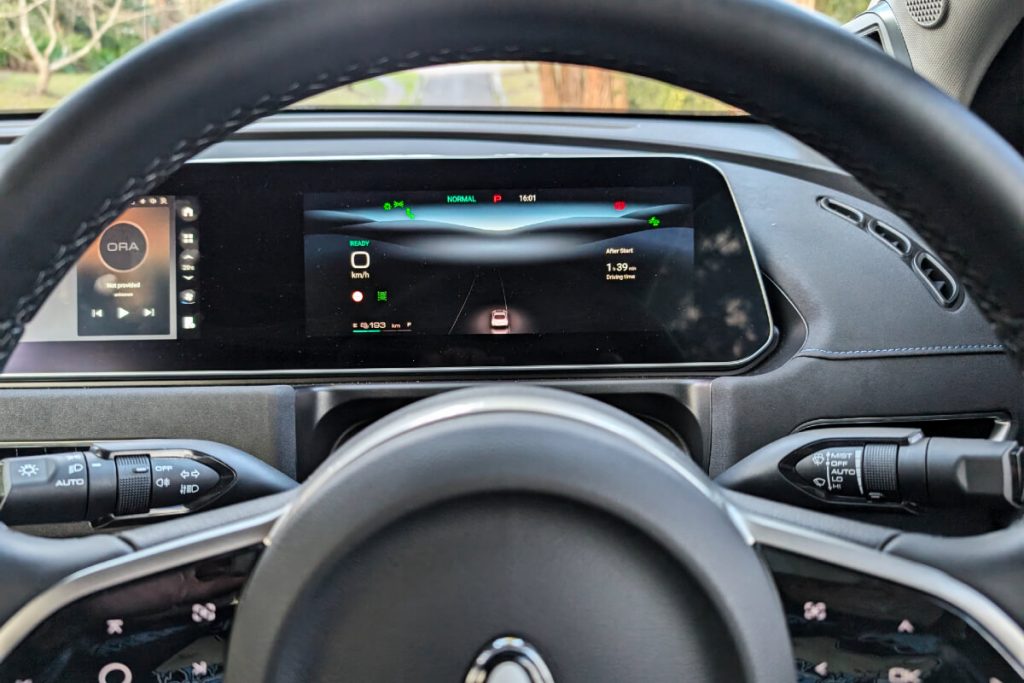Chris Riley tests the 2024 GWM Ora Extended Range EV small SUV with pricing, specs, ride and handling, safety, verdict and everything the over-50 driver needs to know.
Summary: It’s another Chinese electric vehicle from a brand you’ve probably never heard of. But at this price, it has to be worth a look and proves that EVs are coming down in price.
2024 GWM Ora Extended Range electric SUV
Pricing: $40,990 (plus on road costs)
Warranty: Seven-years, unlimited km, five years roadside assist, eight year battery warranty
Safety: 5-star ANCAP (2022)
Engine: electric permanent magnet engine
Service intervals: 15,000km/12 months
Power: 126kW
Torque: 250Nm
Transmission: single-speed reduction gear, front-wheel drive
Body: 4235mm (long); 1825mm (wide); 1603mm (high)
Build country: China
Kerb weight: 1580kg
Towing capacity: not specified
Wheels: 18-inch alloy
Tyres: 215/50R18
Spare wheel: tyre repair kit
Ground clearance: 120mm
Turning circle: 11.2m
Battery: 48kW (Standard Range), 62kW (Extended Range)
Normal charging time: 30 hours 30 minutes
Claimed range: 310km (Standard Range), 420km (Extended Range), 400km (GT)
Consumption: 16.5kWh/100km
Consumption on test: 14.5kWh/100km (300km)
seniordriveraus consumption on test: not tested

[review]
For those looking to buy their first electric car, the GWM Ora could be a prime candidate.
It’s one of the cheaper and better offerings currently available, with prices starting from an affordable $35,990 driveway.
That gets you a stylish, large hatch that is well equipped, with decent range and plenty of performance.
Competitors around the same size and price include the MG4 and BYD Dolphin.
Unsurprisingly, all three are from China – which says something.

What’s it cost?
Ora is available in four grades, with a choice of five two-tone colour combinations.
There’s Standard Range, Extended Range, Ultra and GT, priced from $35,990 plus on-roads for the Standard model.
Extended Range is priced from $40,990, Ultra from $43,990 and the GT from $46,990 – all before on-road costs.
Standard Range and Extended Range are equipped exactly the same.
The only difference lies in the size of the battery and the driving range that it can provide from a single charge.
Standard equipment includes artificial leather and single-zone climate air, 18-inch alloys, a 10.25-inch touchscreen, digital instrument cluster, power-adjust front seats, LED lights front and back, auto lights and wipers, auto dimming rear view mirror, wireless phone charging pad, keyless entry and start, plus Apple CarPlay.
There’s also adaptive cruise control, speed sign recognition and rear parking sensors.
Ultra adds an electric hands-free tailgate, a panoramic sunroof, front parking sensors, heated steering wheel, heated and cooled front seats with massage, plus electric auto-folding mirrors with memory function.
GT ups the ante with some sporty styling cues including different alloys, bumpers and grille, along with red brake calipers that set it apart.
It also gets automatic parking and a light for the vanity mirror.
Infotainment includes a 10.25-inch full colour touchscreen, another 10.25-inch screen for the driver, Bluetooth, AM/FM radio, Apple CarPlay and six-speaker no name audio.
There’s two USB-A ports and a 12-volt outlet in the front and a single USB-A port in the rear, plus a wireless charge pad located conveniently towards the rear of the centre console box.
Missing are DAB digital radio, built-in navigation and Android Auto.
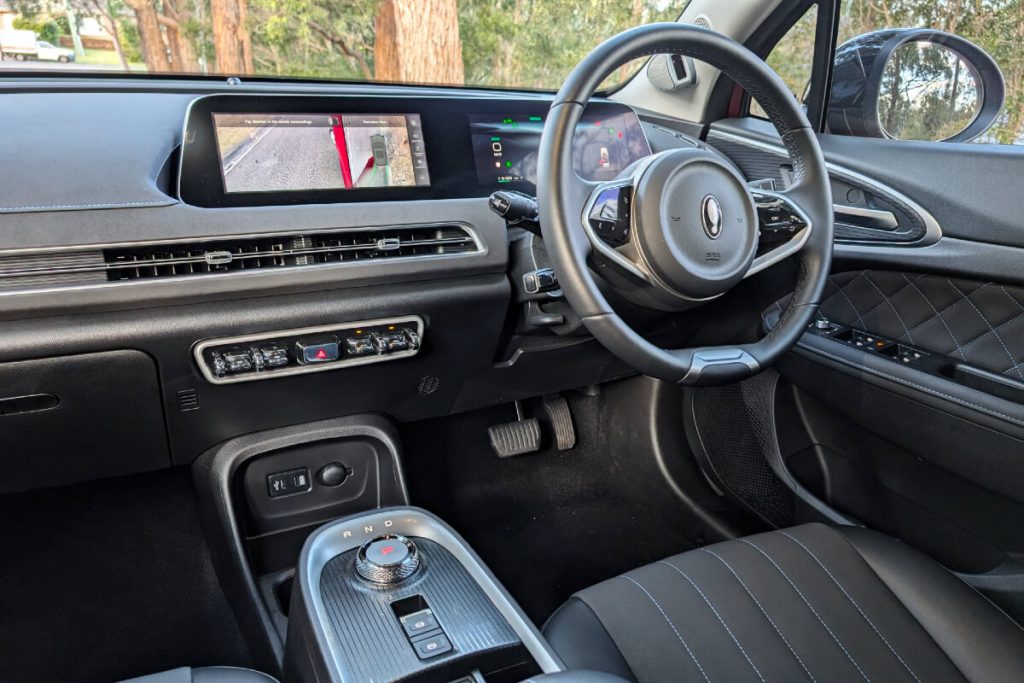
Ora has been awarded five stars for crash safety by ANCAP.
Seven airbags including a centre airbag which provides added protection to front seat occupants in side impact crashes are standard on all grades.
Autonomous emergency braking car to car works at speeds from five to 150km/h, with additional support at lower speeds for vulnerable road users, junction assist and backover.
Also provided are Lane support with lane keep assist (LKA), lane departure warning (LDW), emergency lane keeping (ELK), and a speed assistance system (SAS) are standard.
There’s also blind spot monitor and a 360-degree camera with configurable car display.
ISOFix and top tether child seat anchors are provided for the two outer rear seats, with a top tether for the centre position.
A tyre repair kit is supplied in lieu of a spare wheel.
Ora comes with a 7-year/unlimited kilometre warranty, 8-year battery warranty and 5-years roadside assistance.
Service is required at 12 months or 15,000km, with services capped at $99 for the first five visits.
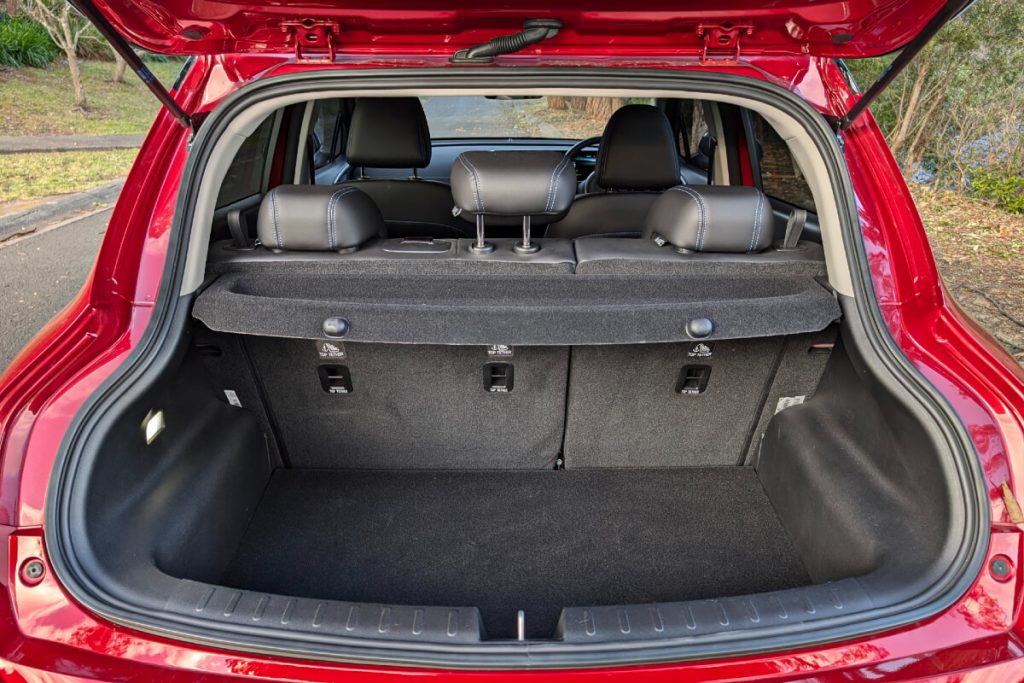
What’s it go like?
First up: Locking and unlocking the car works a little differently to most cars.
Pull the door handle or press the unlock button on the key fob and the car not only unlocks, but powers up ready to roll.
There’s no start/stop button as such. It’s simply a matter of slipping behind the wheel, selecting drive or reverse and you’re good to go.
When you’re done, push P for park and the Ora applies the electric parking brake – well, did you think it was going to be mechanical?
At this point the car remains fully operational. It doesn’t actually turn off until you push the lock button on the key fob.
Here is where we foresee problems. What if you want access to the car but don’t want it running when you do so – for instance when you’re vacuuming the inside?
Getting in and out of the Ora is relatively easy, with wide-opening doors and plenty of headroom for taller people courtesy of the tall stance.
The front seats are wide and accommodating, with power adjustment, but are flat and lack lateral support.
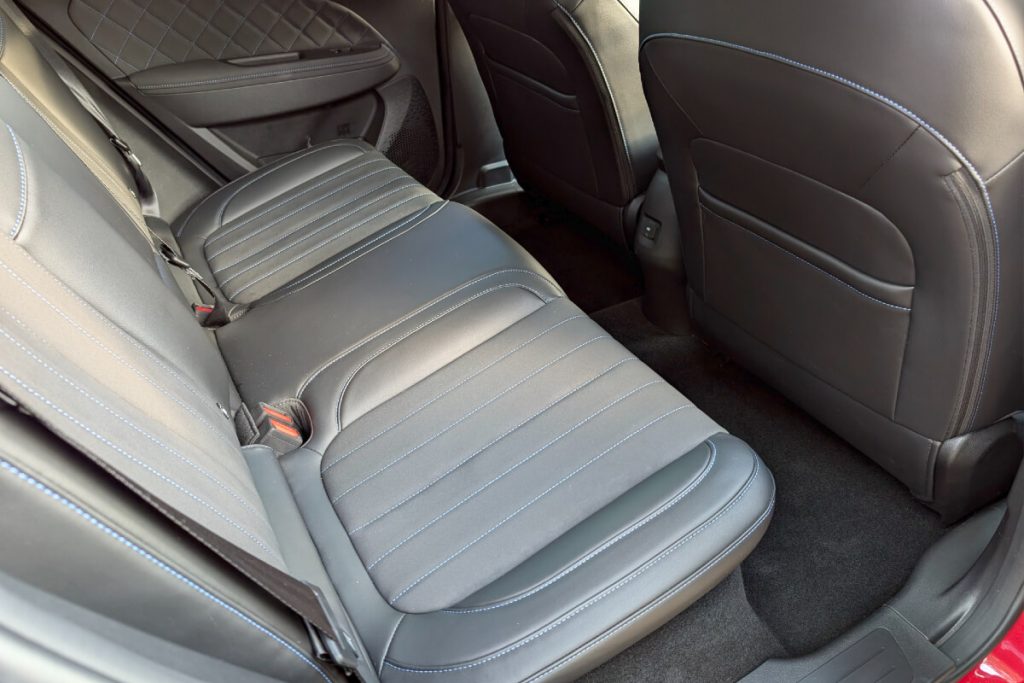
Rear legroom is also generous and the back seat provides comfortable accommodation for two adults or three children.
The trade-off can be found in the boot which is rather small, with only 228 litres of space available behind the rear seat.
And, unlike some EVs, there is no additional storage space available under the front bonnet.
In terms of practicality, the boot will happily accept a few bags of shopping, but the tailgate will not close on medium to large suitcases, which means dropping all or part of the rear seat.
Forward, side and rear vision are good, but the privacy glass makes manoeuvring difficult at night.
The cabin is clean and uncluttered, with two screens housed within a single frame, one for the driver and one for infotainment.
Make sure you set the display to night mode otherwise you might have trouble reading the pale, washed out display.
While you’re at it, be sure to turn off ‘nanny’ cam. That’s the camera mounted on the inside of the front pillar near the driver – or it will drive you nuts.
A row of switches is located below the touchscreen a la Mini, but serves no significant purpose.
The seats are trimmed in artificial leather with contrasting blue-stitching, a design repeated on the doors with a quilted finish.
The top of the dash has an interesting upmarket finish, but just below this plenty of generic black plastic is in evidence.
There’s climate air but alas, no rear air vents.
Also missing are digital radio, built-in navigation and Android Auto. What idiot approved this?
All four grades are fitted with the same single electric motor that produces 126kW of power and 250Nm of torque, with drive to the front wheels via a one-speed automatic transmission.
The auto offers Standard, Sport, Eco, Eco+ and Auto drive modes, along with adjustable brake energy recovery and one-pedal driving.
Standard Range has a 48kWh battery that offers 310km of range (WLTP) while the 63kWh battery in the Extended Range, Ultra and GT grades is good for up to 420km (400km in the case of the GT).
The dash from zero to 100km/h takes 8.4 seconds in all but the GT which ironically does it in 8.5 seconds.
Top speed is 160km/h.
The charge port can be found at the front on the passenger side of the car where there are AC and DC sockets that accept a maximum of 11kWh from an AC charger or 80kW with DC.
Charging the 48kW battery from empty to 100 percent with a standard 10A household power point takes 24 hours.
With an 11kW three-phase AC charger that time drops to 6.5 hours.
With an 80kW DC fast charger zero to 80 percent takes 60 minutes.
With the larger 62kW battery these times are 32 hours, 8.5 hours and 40 minutes.
Them’s the basics anyway.
Our test vehicle was the Extended Range, priced from $40,990 plus on-roads.
It’s a fun, surprisingly practical little car to drive, ideally suited to the requirements of city dwellers provided you have access to the necessary charger.
Ora accelerates quickly and stops sharply, and used as intended for short trips rather than longer interurban travel, we found the car did not require charging over the week that we had it.
Weighing 1540kg, with a low centre of gravity, it feels planted and handles pretty well, as we discovered pushing hard through some corners over some favourite less travelled roads.
The one blot in an otherwise exemplary copy book is a lousy turning circle, evidenced by the lack of lock displayed by the front wheels in our photos.
And the tyres do however generate quite a bit of noise on coarse bitumen.
Rated at 16.5hWh/km, we were getting 14.5 after just over 300km of mixed driving.
What we like
- Stylish
- Quality feel
- Well equipped
- Satisfying performance
- Relatively cheap for an EV
- Perfect for city dwellers with access to power
What we don’t like
- Small boot
- Small turning circle
- No rear air vents
- Too many features controlled from touchscreen
- Nanny cam
- Tugs a bit
- No DAB
- No satnav
- No Android Auto
- Tyre noise on coarse bitumen
- some cheap plastics
What over-50s need to know
Ora’s kind of cute and relatively cheap for an EV.
It goes pretty well too, and has the sort of range that you can work with if your driving is confined to the suburbs.
The price puts Ora within reach of the majority of punters and that makes it an ideal choice for those who are keen to get into an electric car.
In fact, the designers have kept things nice and simple, so even if you haven’t had any experience with EVs until now, it won’t take you long to adapt.
However, the lack of Android Auto is a major oversight, especially without built-in navigation to fall back on – one that will hopefully be addressed soon.
And let’s not forget that seven-year warranty. That’s money in the bank, people. Good job.
seniordriver comments
Small electric SUVs seem to come down in price almost every day. The GWM Ora costs pretty much what you’d expect an internal engine SUV to cost, so it’s remarkably good value.
And quite stylish.
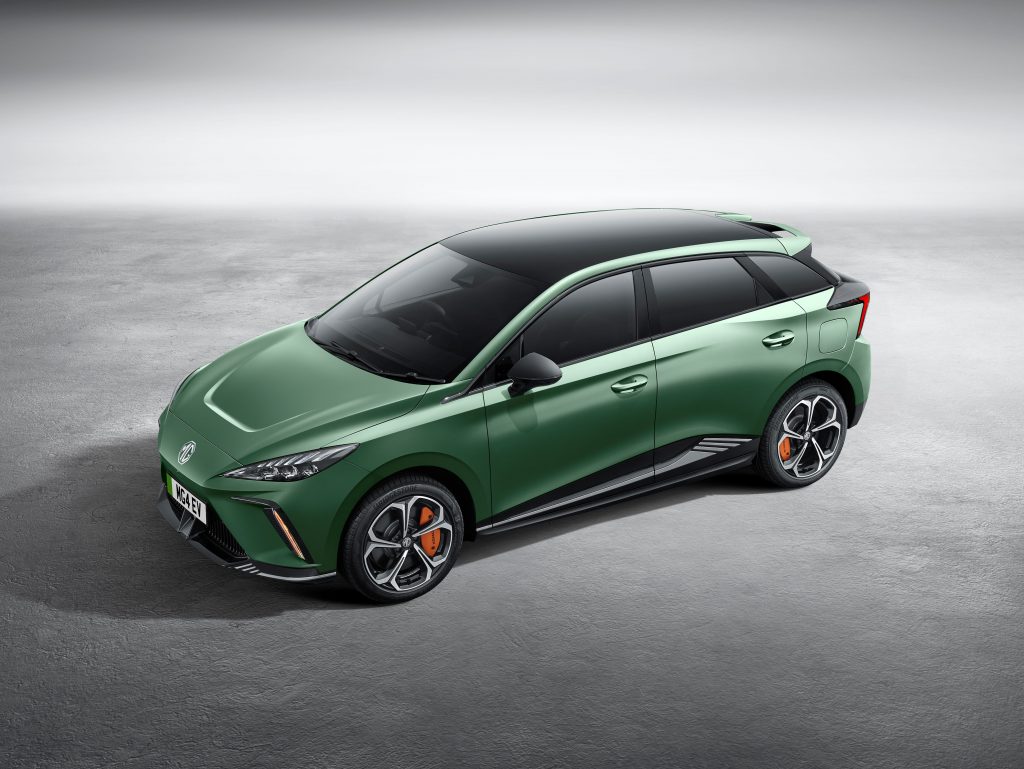
The MG4 EV starts from $38,990 in Australia, undercut by the BYD Dolphin at $38,890, which might go some way to explaining the price cut in the Ora. And as we were about to file this story, MG announced it has dropped its prices to $34,990 (driveaway) for the ZS EV and a further reduction for the MG4 to a starting price of $37,990. Additionally, they have made a strong increase in warranty cover, a ten-year 250,000km warranty across the entire range.
Once again, the Ora’s predicted range is hardly likely to inspire great confidence and you won’t want to be heading off on any long journeys.
The absence of DAB digital radio, built-in sat nav and Android Auto are hard to understand (although you can pair your phone and use it’s Google maps, if you wish).
Another oddity is a seven-year warranty but only five years road assist.
Wide-opening doors will appeal to over-50s drivers, as will the generous leg room. Not so appealing is the relatively skimpy luggage space at 228 litres. You’ll fit the shopping in, but not much else.
